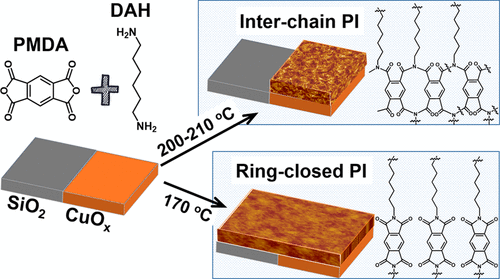当前位置:
X-MOL 学术
›
Chem. Mater.
›
论文详情
Our official English website, www.x-mol.net, welcomes your
feedback! (Note: you will need to create a separate account there.)
Area-Selective Molecular Layer Deposition of Polyimide on Cu through Cu-Catalyzed Formation of a Crystalline Interchain Polyimide
Chemistry of Materials ( IF 7.2 ) Pub Date : 2020-06-03 , DOI: 10.1021/acs.chemmater.0c00898 Chao Zhang 1 , Marko Vehkamäki 1 , Mika Pietikäinen 2 , Markku Leskelä 1 , Mikko Ritala 1
Chemistry of Materials ( IF 7.2 ) Pub Date : 2020-06-03 , DOI: 10.1021/acs.chemmater.0c00898 Chao Zhang 1 , Marko Vehkamäki 1 , Mika Pietikäinen 2 , Markku Leskelä 1 , Mikko Ritala 1
Affiliation

|
Novel area-selective molecular layer deposition (AS-MLD) of polyimide (PI) on Cu versus native SiO2 was studied. By use of 1,6-diaminohexane (DAH) and pyromellitic dianhydride (PMDA) as precursors, PI films can be selectively deposited on the Cu surface at 200–210 °C with a rate around 7.8 Å/cycle while negligible growth takes place on SiO2. The selectivity was successfully demonstrated also on Cu/SiO2 patterns at 200 °C; after 180 MLD cycles, around 140 nm thick PI was deposited on Cu regions while <10 nm thick PI was measured on SiO2 regions. By contrast, at 170 °C, similar growth rates were measured on Cu (4 Å/cycle) and native SiO2 (5 Å/cycle). To understand the origin of the selectivity, properties of PI film grown on Cu at the selectivity enabling temperature of 200 °C have been thoroughly compared with those grown on both Cu and native SiO2 at the nonselective temperature of 170 °C. Significant differences in crystallinity, surface morphology, and chemical structure suggest that the PI films grown on Cu at 200 °C have a novel crystalline interchain PI structure. According to this finding, the selectivity mechanism is proposed to derive from a new MLD reaction mechanism catalyzed by copper ions at 200–210 °C that leads to the formation of new crystalline polymer species. Additionally, it is suggested that small amounts of Cu ions can float on the surface of the growing PI film and thereby constantly catalyze the MLD reaction, as evidenced by XRD, XPS, and ToF-ERDA. The high catalytic efficiency has been also proven by using successfully an ultrathin Cu layer, nominally 0.1 nm, as a seed layer to initiate the MLD growth.
中文翻译:

通过Cu催化形成的结晶链间聚酰亚胺,在Cu上进行聚酰亚胺的区域选择性分子层沉积
研究了相对于天然SiO 2在铜上聚酰亚胺(PI)的新型区域选择性分子层沉积(AS-MLD)。通过使用1,6-二氨基己烷(DAH)和均苯四甲酸二酐(PMDA)作为前体,可以在200–210°C下以大约7.8Å/周期的速率将PI膜选择性地沉积在Cu表面上,而在SiO 2。在200°C的Cu / SiO 2图案上也成功证明了选择性。经过180次MLD循环后,在Cu区域沉积了约140 nm厚的PI,而在SiO 2区域测量了<10 nm厚的PI 。相比之下,在170°C下,对Cu(4Å/循环)和天然SiO 2的测量增长率相似(5Å/周期)。为了了解选择性的起源,已经将与在Cu和天然SiO 2上生长的PI膜相比,在200°C的选择性使能温度下在Cu上生长的PI膜的性能进行了全面比较在170°C的非选择性温度下。结晶度,表面形态和化学结构的显着差异表明,在200°C的铜上生长的PI膜具有新颖的结晶链间PI结构。根据这一发现,提出了选择性机理,该选择性机理源于200-210°C的铜离子催化的新的MLD反应机理,该反应导致形成新的结晶聚合物。另外,正如XRD,XPS和ToF-ERDA所证明的那样,建议少量的Cu离子会漂浮在生长的PI膜表面上,从而不断催化MLD反应。通过成功使用标称0.1 nm的超薄Cu层作为启动MLD生长的种子层,也证明了高催化效率。
更新日期:2020-06-23
中文翻译:

通过Cu催化形成的结晶链间聚酰亚胺,在Cu上进行聚酰亚胺的区域选择性分子层沉积
研究了相对于天然SiO 2在铜上聚酰亚胺(PI)的新型区域选择性分子层沉积(AS-MLD)。通过使用1,6-二氨基己烷(DAH)和均苯四甲酸二酐(PMDA)作为前体,可以在200–210°C下以大约7.8Å/周期的速率将PI膜选择性地沉积在Cu表面上,而在SiO 2。在200°C的Cu / SiO 2图案上也成功证明了选择性。经过180次MLD循环后,在Cu区域沉积了约140 nm厚的PI,而在SiO 2区域测量了<10 nm厚的PI 。相比之下,在170°C下,对Cu(4Å/循环)和天然SiO 2的测量增长率相似(5Å/周期)。为了了解选择性的起源,已经将与在Cu和天然SiO 2上生长的PI膜相比,在200°C的选择性使能温度下在Cu上生长的PI膜的性能进行了全面比较在170°C的非选择性温度下。结晶度,表面形态和化学结构的显着差异表明,在200°C的铜上生长的PI膜具有新颖的结晶链间PI结构。根据这一发现,提出了选择性机理,该选择性机理源于200-210°C的铜离子催化的新的MLD反应机理,该反应导致形成新的结晶聚合物。另外,正如XRD,XPS和ToF-ERDA所证明的那样,建议少量的Cu离子会漂浮在生长的PI膜表面上,从而不断催化MLD反应。通过成功使用标称0.1 nm的超薄Cu层作为启动MLD生长的种子层,也证明了高催化效率。











































 京公网安备 11010802027423号
京公网安备 11010802027423号